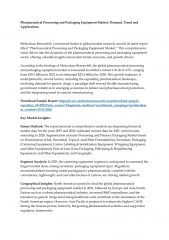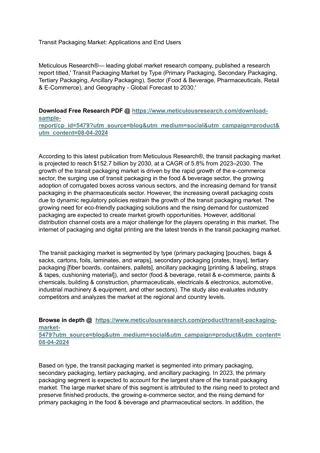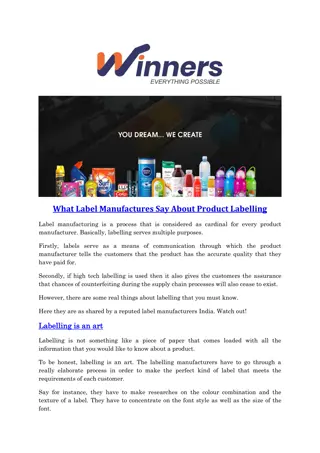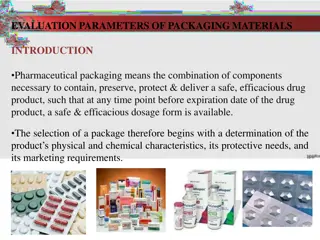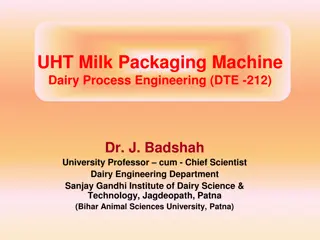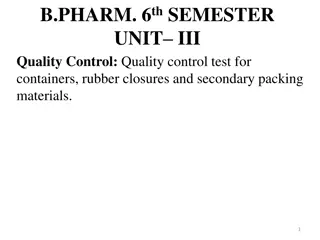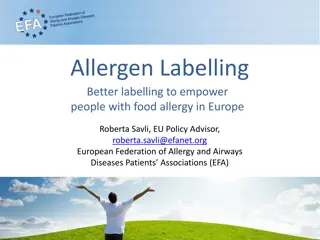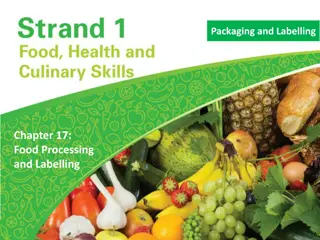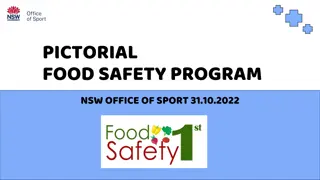Understanding Food Packaging and Labelling Requirements in NSW Education
Learn about the importance of food packaging options, including materials used and the roles they play in protecting food products. Explore the reasons for food packaging in terms of preservation, marketing, and consumer information needs. Discover the legislative requirements for food labelling in Australia and New Zealand, ensuring consumer safety and information transparency. Gain insights into the standards enforced by the NSW Food Authority for compliant food labelling practices.
Download Presentation

Please find below an Image/Link to download the presentation.
The content on the website is provided AS IS for your information and personal use only. It may not be sold, licensed, or shared on other websites without obtaining consent from the author. Download presentation by click this link. If you encounter any issues during the download, it is possible that the publisher has removed the file from their server.
E N D
Presentation Transcript
NSW Department of Education Food product development presentation 3
NSW Department of Education Food packaging options The goal of food packaging is to contain food and should be cost-effective, satisfying industry requirements and consumer desires, maintaining food safety and minimising the impact on the environment. Roles of Food Packaging The primary roles of food packaging are to: protect food products from outside influences and damage contain food provide consumers with ingredient and nutritional information. The secondary roles of food packaging are: traceability convenience tamper indication.
NSW Department of Education Reasons for food packaging There are a range of reasons for packaging of food, such as: protection/preservation containment and food waste reduction marketing and information traceability convenience tamper indication other functions.
NSW Department of Education Materials used in food packaging considerations Materialsin food packaging include: glass metal aluminium aluminium Foil laminates and metallised films tinplate tin-free steel paper and cardboard plastics, such as polyolefins, polyesters, polycarbonate, polystyrene, polyamid, laminates and co-extrusions.
NSW Department of Education Legislative food labelling requirements Image from Publicdomainfiles CC PD 1.0
NSW Department of Education Food labelling requirements - laws All food labels in Australia and New Zealand must contain the following information: name and/or description of the food/food product identification of the lot number, in the case that food is recalled name and Australian or New Zealand street address of the supplier of food, in the case of the food being recalled list of ingredients date markings - use by/best before nutrition information panel country of origin warning and advisory statements - health warnings.
NSW Department of Education Food labelling requirements - standards The NSW Food Authority is responsible for enforcing the labelling provisions of the Food Standards Code. Chapter 1 of the Food Standards Code covers general labelling and information requirements that are relevant to all foods, and sets out which requirements apply in different situations For example food for retail sale and food for catering purposes or an intra-company transfer Chapter 2 covers specific labelling and information requirements that apply to certain food products only The Food Authority also administers the labelling requirements of the Food Act 2003 (NSW), which contains sections about the provision of information that could mislead consumers that is dietary claims.
NSW Department of Education Food-labelling requirements- country of origin As of 1 July 2018 new food labelling on products are mandatory. The new labelling system is administered under Australian Consumer Law and no longer a requirement under the Food Standards Code.
NSW Department of Education Declaring Food Allergens All food retailers, manufacturers and importers are responsible for managing the presence of allergens in food. Food businesses must meet the labelling requirements set out in Standard 1.2.3 (Mandatory Warning and Advisory Statements and Declarations) of the Food Standards Code. The ten most common allergens are: crustaceans fish gluten eggs milk lupin peanuts soybeans tree nuts sesame seeds.
NSW Department of Education Food labelling requirements - date marks & storage Date marking and storage labelling helps to determine the shelf life of food products. Food manufacturers are responsible for determining the shelf life of food products and must be able to substantiate the indicated storage period to enforcement authorities. Standard 1.2.5 (Information requirements - Date marking of food for sale) of the Food Standards Code outlines the form in which packaged foods must be date-marked to indicate their shelf life. For example a use by statement/ best before statement. For reasons of health and safety, the consumer needs to be informed of the directions/ use of a food, which needs to be included on the label. The Food Standards Code requires the manufacturer to include on the label a statement of any specific conditions required to ensure that the food will keep for the period indicated by the date mark, eg. refrigerate after opening.
NSW Department of Education Food labelling requirements health and nutrition claims Reference to a relationship between a food and it's health benefits and are only permitted on foods that meet the nutrient profiling scoring criterion that is claims are restricted to foods which support overall health. Nutrition content claims are claims about the content of certain nutrients or substances in a food that is low sugar, fat, salt. The Food Standard Code contains 200 pre-approved food health relationships that any health claim must comply with. From January 2016, food businesses must comply with criteria set out in Standard 1.2.7 (Nutrition, health and related claims) for food labels and advertisements.
NSW Department of Education Food labelling requirements health star ratings The health star rating is a national voluntary front of pack labelling system that uses stars to show the nutritional profile of packaged foods.
NSW Department of Education The elements of the marketing mix
NSW Department of Education The marketing mix A producer/business aims to identify, attract and satisfy customers and consumers. The traditional approach to creating a marketing plan is based on four components, known as the 4P s of the marketing mix: product planning: having the right product/service price: having the product/ service at the right price placement & distribution: having the product/service in the right place at the right time promotion: the product is actively promoted to the target market.
NSW Department of Education The elements of the marketing mix Product is the goods and/or services offered to the target market. This includes: research development and testing the number of items to be included in the product mix that is portion size, packaging, branding and product launch. Price is the amount of money customers and consumers pay to obtain the product. Pricing decisions will include: assessment of the market conditions and competition desired returns on investment product positioning image such as price/quality relationships (value for money).
NSW Department of Education The elements of the marketing mix continued - place and promotion Place includes business activities such as distribution, that make the product available to the target market. Decisions must be made as to: how many participants there will be in the distribution process physical locations the product will be made available (direct or indirect) such as in a supermarket or online catalogues/orders logistics and inventories Promotion includes all activities that communicate the benefits of the product and persuade the target market to buy it. This includes activities such as advertising, celebrity endorsements and media campaigns, sampling.
NSW Department of Education Practical task McDonalds video game
NSW Department of Education New food products and their effect on society, the environment and health Players manage a supply chain in the food-focused corporation of McDonald s. McDonald s Videogame shows players the negative impact on modern society, environment and health from the rising demand for products created by consumers. Navigate to the link below McDonalds video game- sustainability website Play the game a few times to perfect the applications then complete the task. Task: Outline the steps involved in the production task undertaken in the McDonalds video game.





